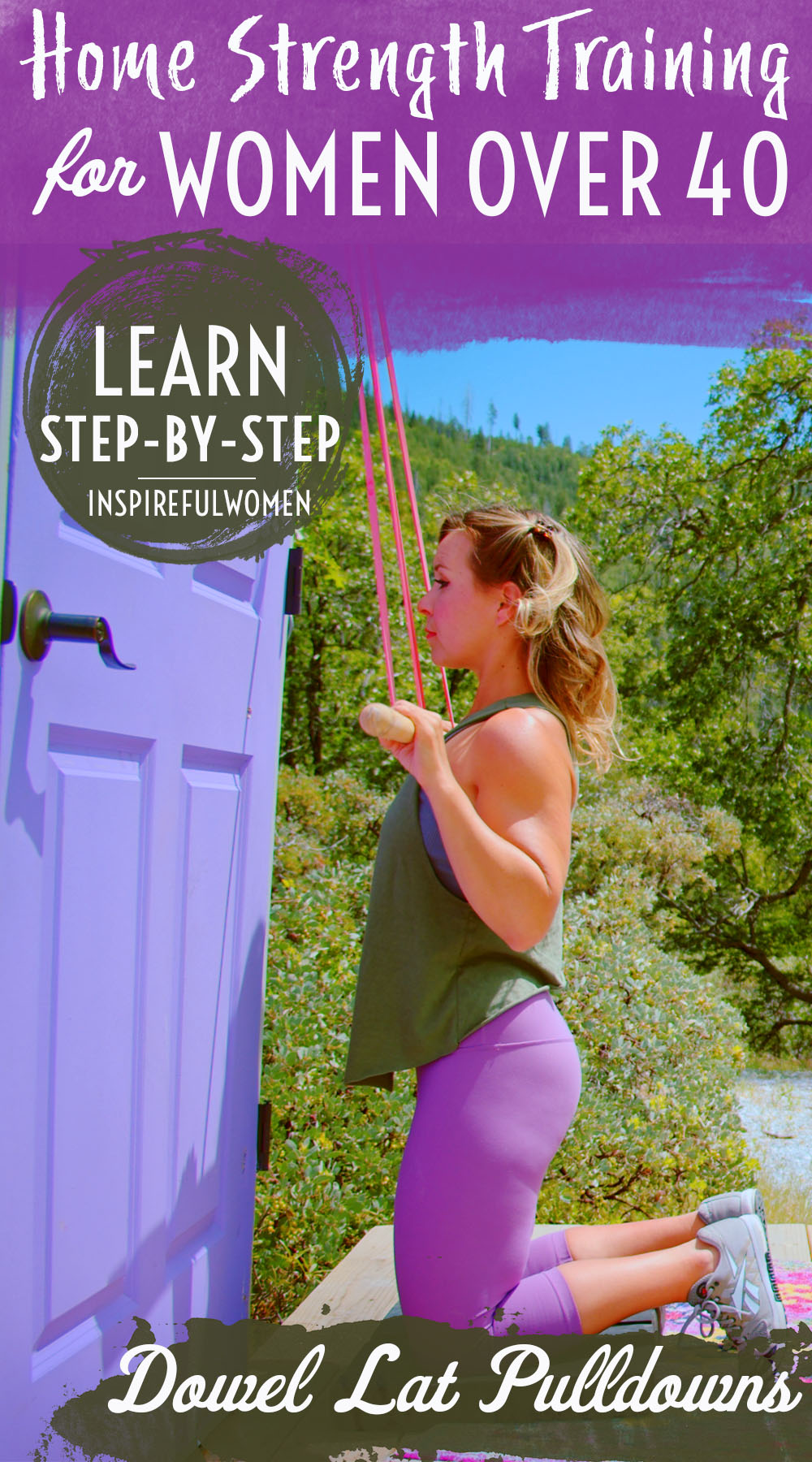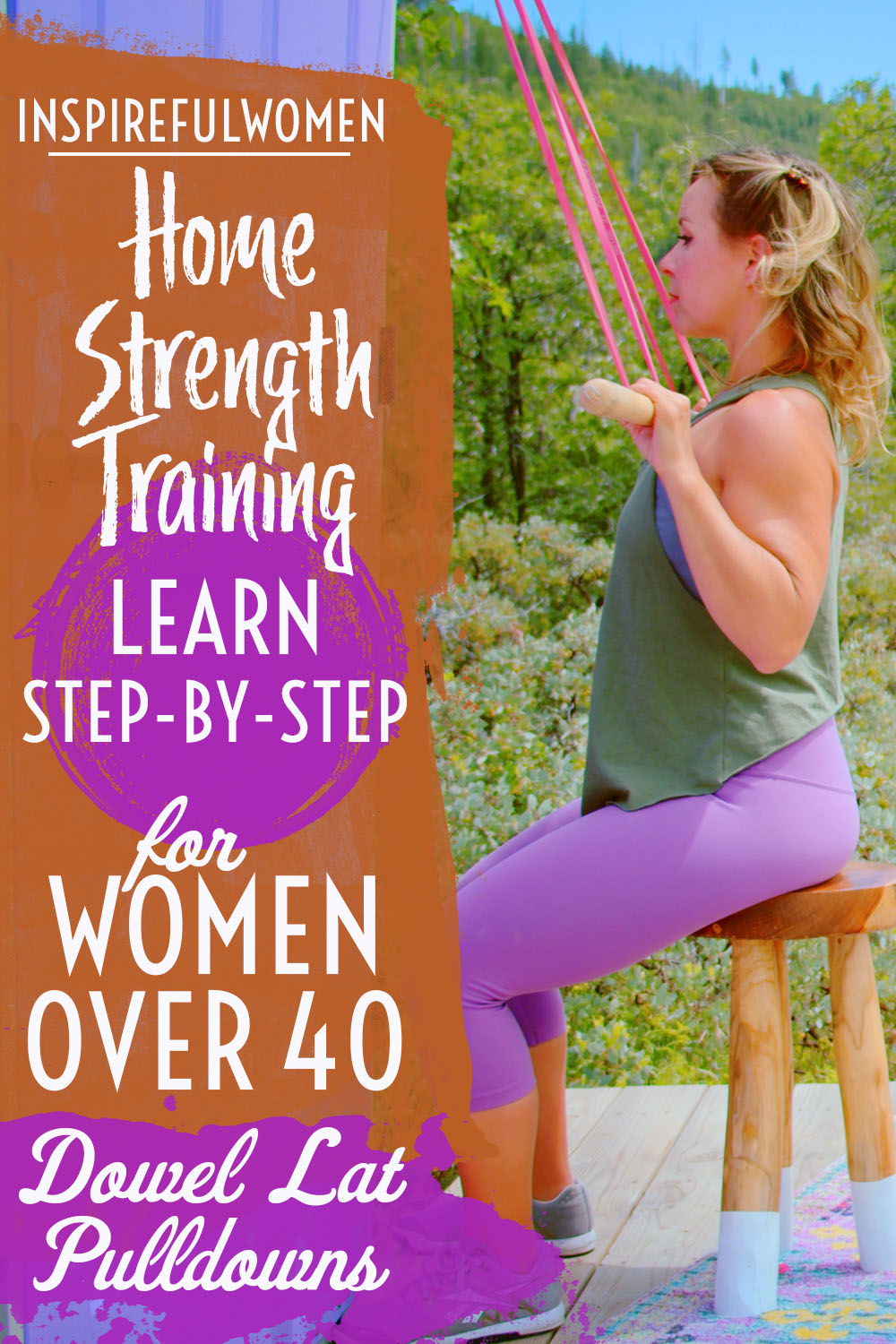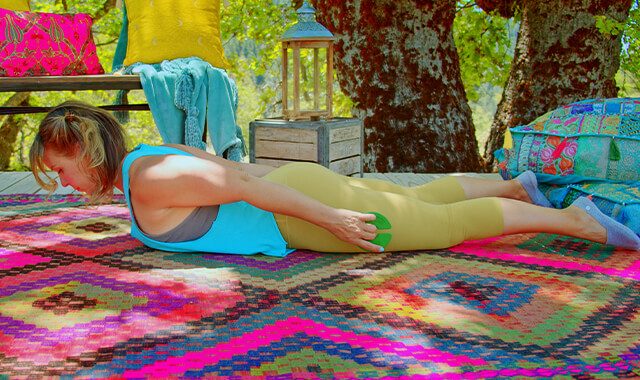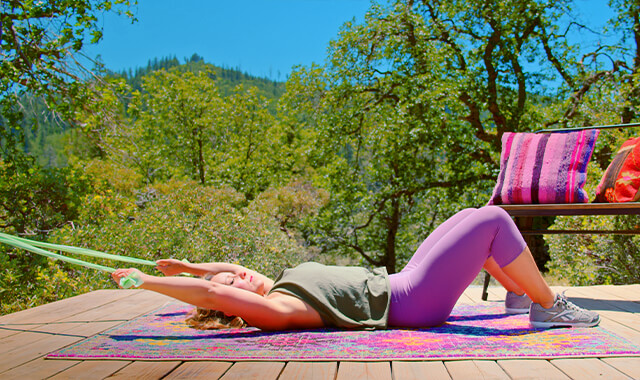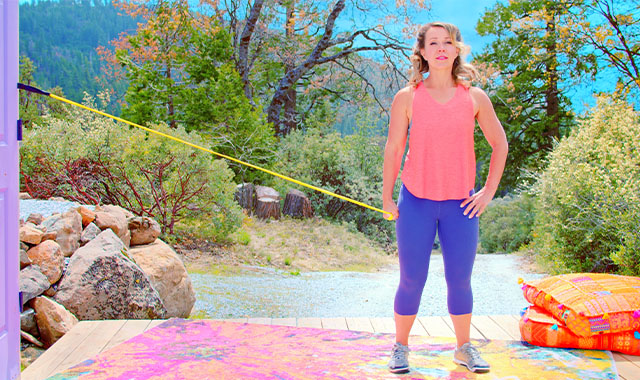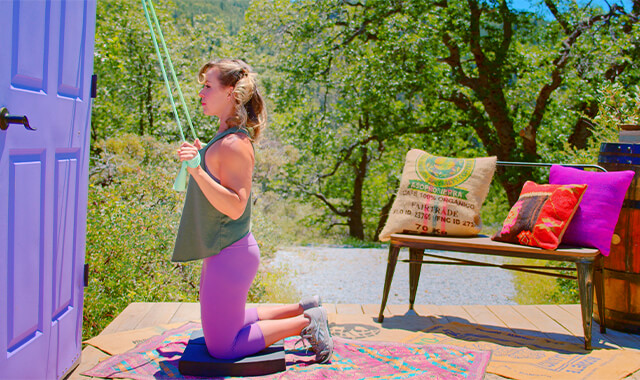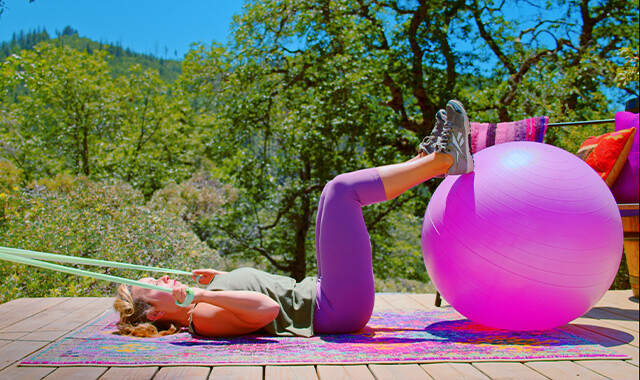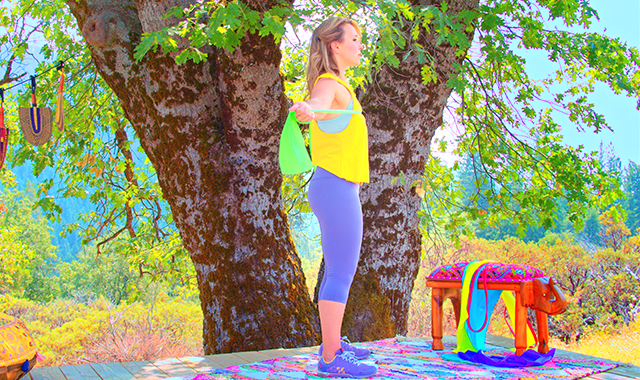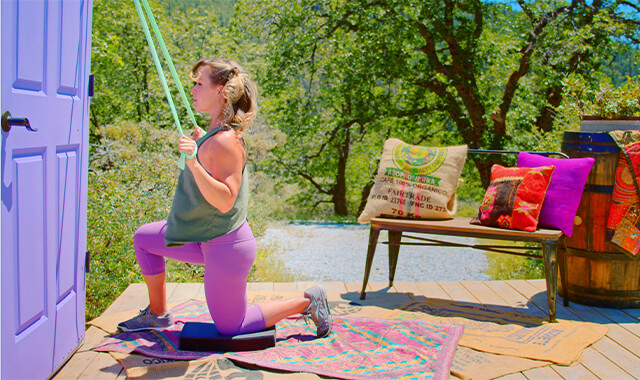Kneeling Dowel Lat Pulldown
How to Do the Kneeling Lat Pulldown w/ Dowel + Band | In-Depth Guide [VISUAL LEARNERS] Beginner
Proper Form & Common Mistakes | Home Resistance Training
WHAT DO YOU WANT TO SEE?
QUICK DEMO
QUICK DEMO
MUSCLES THIS WORKS
MUSCLES
MAIN MUSCLES WORKED IN Kneeling Dowel Lat Pulldowns
LATISSIMUS DORSI
OTHER MUSCLES WORKED:
- Lower and mid traps
- Pectoralis major
- Rhomboids
- Serratus anterior
- Teres major
STARTING POINTERS
Starting Pointers
WHAT WE'RE DOING TODAY
ALL WE'RE DOING:
Pull both ends of the band down towards your torso, letting your elbows bend.
This is the standard version of the lat pulldown using a dowel to pull the band down (since the idea if you're hanging out here at Inspireful Women is that we are at home, not a gym where there are machines for movements like this. This is a nice option if holding the band is not comfortable for your hands.
It requires a dowel approximately 3 feet long (I've also used a broom handle- with the broom still attached!) It is also good if you have one arm that is tighter or weaker. The more flexible and stronger shoulder can move the arm further and the other arm will be moved through the larger range.
HOW TO DO THE EXERCISE
LOOKS
HOW Kneeling Lat Pulldowns w/ Dowel + Band SHAPE OUR BODY
Good posture, slim V waist (hourglass shape).
PROPER FORM
PROPER FORM: Dowel Lat Pulldown
EQUIPMENT, SETS & REPS
EQUIPMENT
Main set (3: Light/Med/Heavy)
X-Heavy Band (I recommend getting this too if you plan to use resistance bands frequently).
Dowel - approximately 3 feet long, evenly weighted
SUGGESTED STARTING WEIGHT FOR WOMEN:
Moderate resistance bands
SETS & REPS:
2 sets of 8 reps
PACE:
Moderate pull down - with control and back stability, and slower return to start.
BODY POSITION
BODY POSITION FOR THE Kneeling Lat Pulldown - Dowel + Band
BAND: There are two options:
- Two ends of the band are attached to the dowel. Tie or loop one end of the band to one side of the dowel, slide it over or through the anchor and attach the other end of the band to the other side of the dowel; or
- Attach one end of the band to the center of the dowel and the other end to the anchor. Anchor the band so that your arms will be lifted out to your sides - a little more than halfway between straight out to the side and straight overhead when you are sitting. The higher your arms are the larger the movement will be. You should be able to pull your upper arm all the way down to your torso. Stand facing the anchor.
FEET: Hip width apart, toes forward
BODY STANCE: Knees slightly bent to provide a stable base to work off of. Neutral spine (includes neck), sternum lifted.
HAND/GRIP: Your hands are placed on the dowel, approximately 2 inches wider than your shoulders. The band attachment should be inside your hands when gripping the dowel. Grip: pronated - palm down.
ARMS: Arms overhead holding the dowel. Your upper arms are slightly in front of your trunk (30 degrees forward - in the scapular plane). Elbows slightly bent.
HOW TO DO
HOW TO DO Kneeling Dowel Lat Pulldowns
CUE: Keep the dowel level as you pull it down.
Pull your upper arms down to the sides of your torso, your shoulder blades will move down your back and in towards your spine.
Your elbows will bend as your arm comes down.
Pause at the end of the movement and then slowly return to the starting position.
HOW TO SAFELY GET OUT OF THE EXERCISE
Return to the starting position and release the bands.
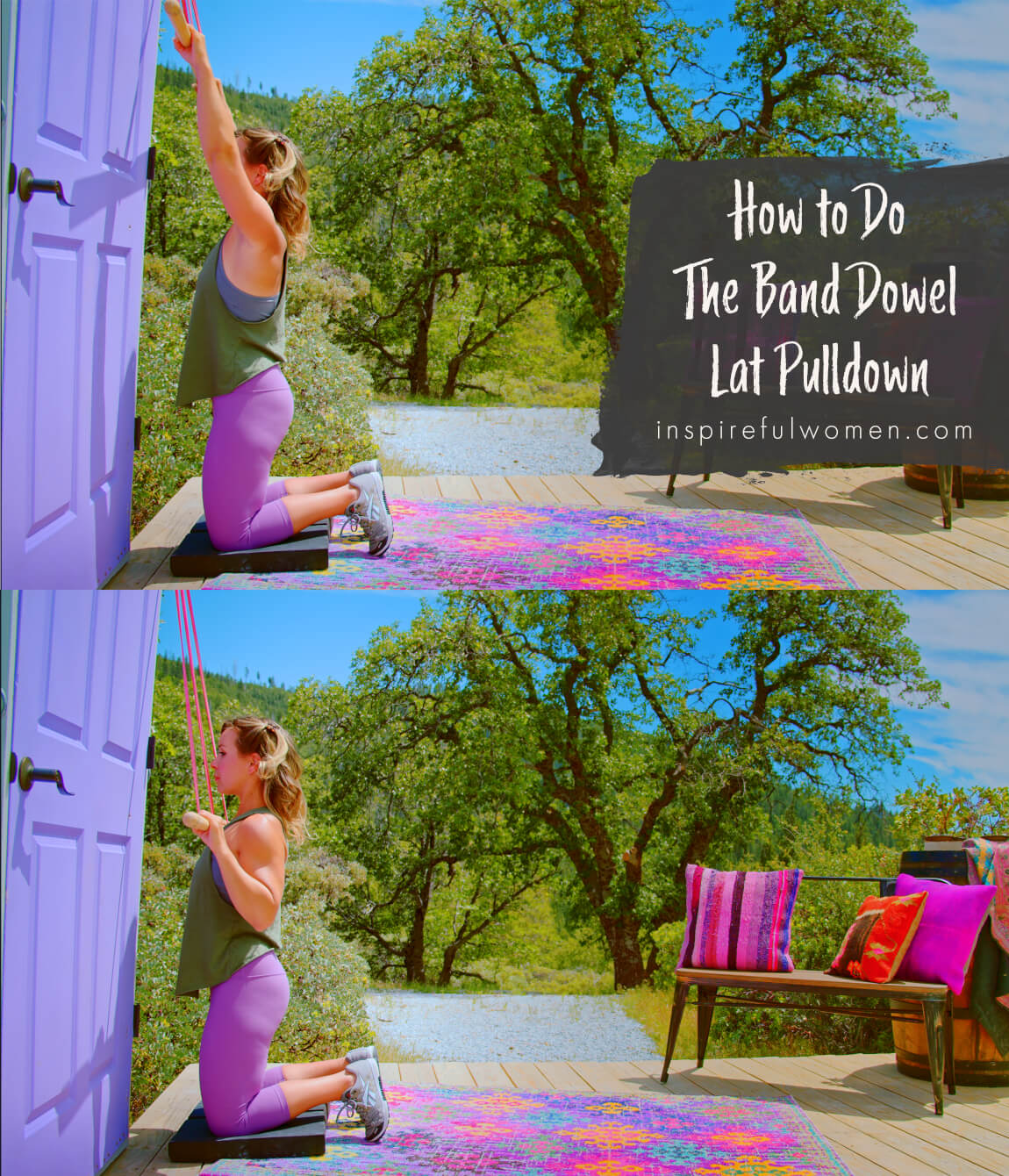
COMMON MISTAKES
COMMON MISTAKES
WHAT TO AVOID WITH THE Kneeling Dowel Lat Pulldown
KEY TIP:
Guess what? Good news! Many avoids are the same for most movements. Once you learn the basics, there's really only a few extra avoids for each individual movement.
1. Avoid Leaving Shoulders Up
AVOID: Letting the shoulders hunch up.
WHY NOT?
- This is not healthy for the shoulder joint.
WHAT TO DO:
- Pull the shoulder blades down.

2. Avoid leaning back
AVOID: Leaning back.
WHY NOT?
- This will decrease the work being done by the muscles of the arms and upper back
- This is a common way the brain will try to make the exercise easier - using your body weight to pull the band back by leaning backward.
WHAT TO DO:
- Keep the shoulders over the hips, over the feet.
- Activate your core muscles.
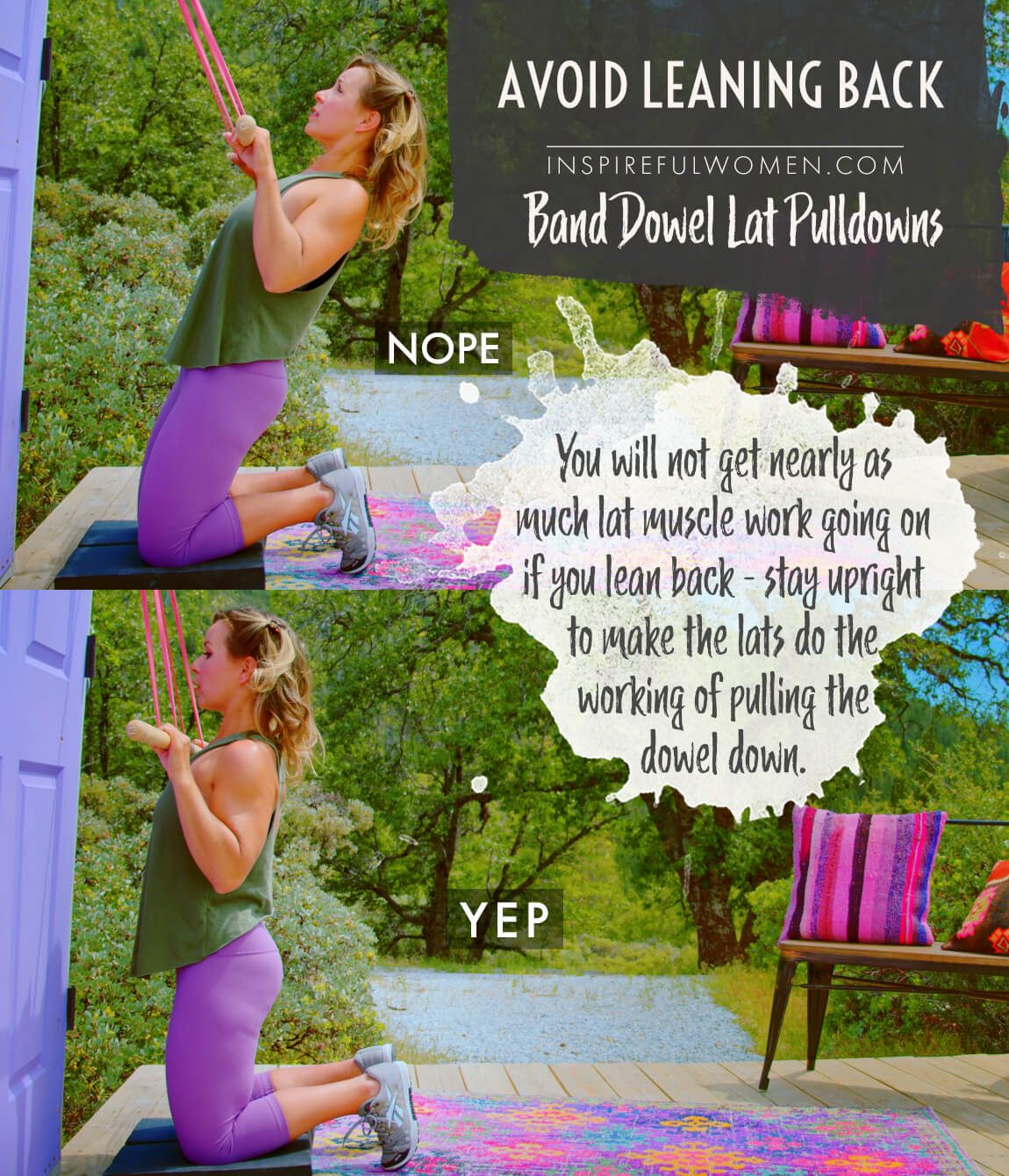
3. Avoid band outside hands
AVOID: Hands too close.
WHY NOT?
- The hands will move in, closer to the shoulders.
- This will move the resistance closer to the shoulder joint and the muscles will not need to work as hard.
WHAT TO DO:
- Keep your hands outside of band.
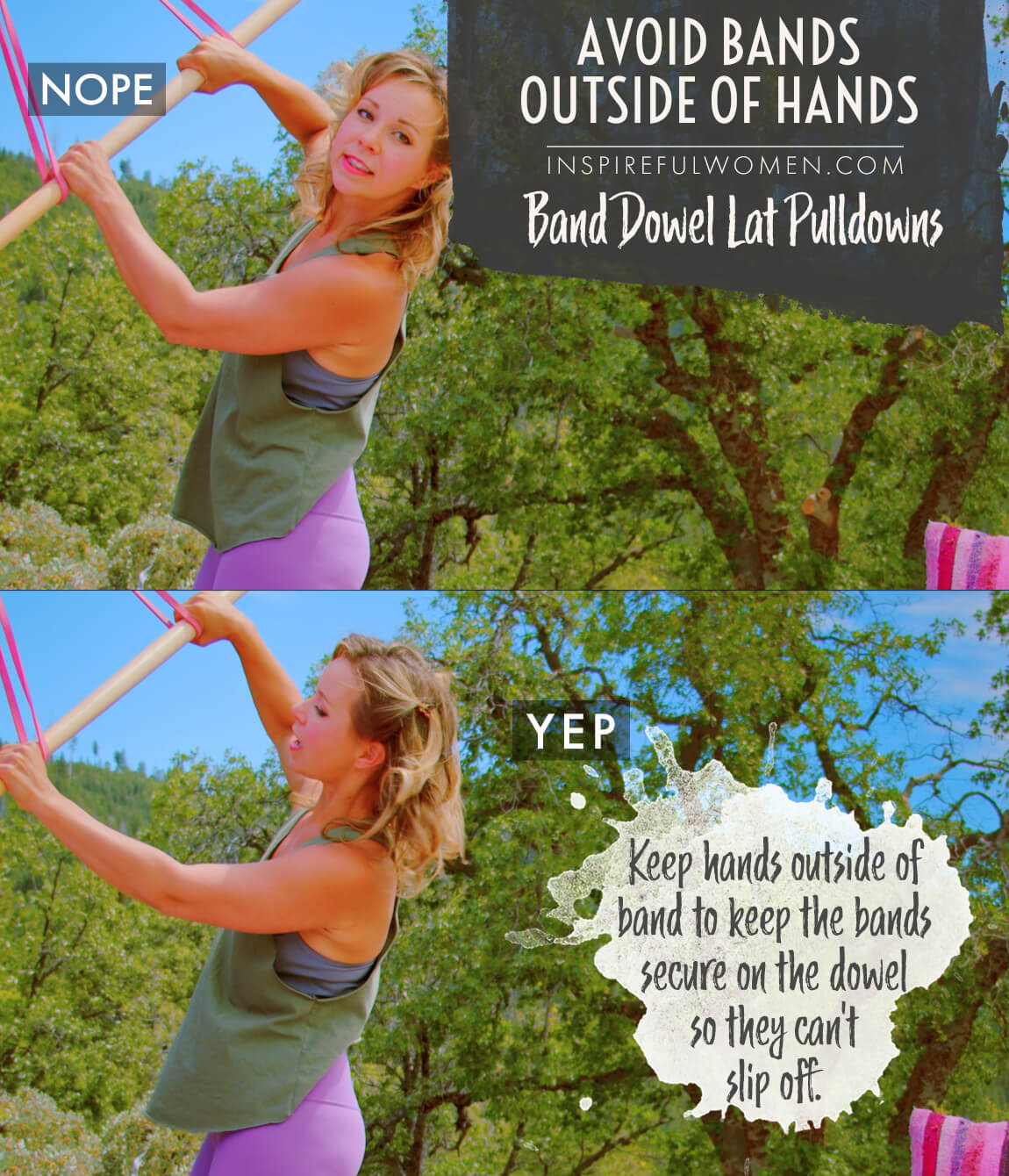
VARIATIONS
VARIATIONS
VARIATIONS OF Kneeling Dowel Lat Pulldowns
Seated Band Dowel Lat PUlldown
Seated
The seated variation of the lat pulldown is more stable so the core and leg muscles will not have to work as hard to hold an upright position. In the seated position you may be able to work your arms through a larger range of motion (depending on where the band is anchored). The seated position may allow you to use a heavier resistance band because it is a more stable position.
Set Up: Seated upright without leaning on the back of the chair, feet flat on the floor.

WHAT WE'RE DOING TODAY
WHAT & WHY
BENEFITS OF TRAINING THE LATISSIMUS DORSI
WHAT
Lat pulldowns are different from lat pushdowns in that you let your elbows bend, rather than keeping the arms straight. This motion lets you use more resistance than in a pushdown AND reduces how much the triceps contribute to the exercise.
Pulldowns work many muscles of the back and shoulders, with a focus on the largest muscle of the back, the latissimus dorsi - often referred to as the “lats”, while minimizing the work done by the triceps. Lat pulldowns involve stabilizing the torso while pulling the arms down and in towards the sides of the body (extension and adduction). This exercise trains posture and core stability, during the movement of the shoulder blade and arm.
WHY BOTHER DOING IT?
WHY
WHY DO WE EVEN CARE?
TRAINS YOU TO LIFT MORE WEIGHT + REDUCE INJURY RISK
The latissimus dorsi is a large flat muscle that runs across your back from about mid spine all the way down to the pelvis, it crosses the bottom part of your shoulder blade and runs under your armpit to attach to the upper arm bone. The latissimus dorsi can pull the arm down and back (extension), in towards the body (adduction), and internally rotate the arm. The attachments to the spine and the pelvis make it an important muscle for holding the torso still - it is like a large back brace of muscle and fascia (fascia is thin, strong connective tissue).
Lat pulldowns involve stabilizing the torso while pulling the arms down. Training your core muscles, including the large lat to hold your torso still will allow you to move more weight and decrease your risk for injuries.
BALANCE OUT OUR COMMONLY TIGHT FRONTS
Not only do the lats stabilize the spine and move the arms, they also pull the shoulder blades down the back. This is important for healthy shoulder movement and good posture. Most of our daily activities involve working in front of us, using the muscles of the front of the body. The muscles on the front of the body pull the shoulders and the shoulder blades forward. It is important to balance this out by working the muscles of the back of the body that pull the shoulders and shoulder blades back.
TRAIN WHAT CONNECTS OUR UPPER & LOWER BODY - SEEMS LIKE A SMART THING TO DO?
The latissimus dorsi connects the upper body with the lower body, it is broad and covers more area than any other back muscle.
As such, it helps coordinate something called reciprocal movement of the arms and legs during walking and running, sports - like batting, golf, tennis. If that term is confusing, it was to me! I was like recipro-what? Insert raised eyebrow. This is just a technical term to describe the way in which we naturally move our bodies when doing things like walking- meaning when your right foot takes a step forward, your left arm naturally swings forward as well. And vice versa. This is what creates balanced movement for us along with a little momentum that helps propel us forward so that it doesn't require as much effort to move our bodies through space.
In more scientific speak, the force is transmitted from the ground, up the legs across the low back and to the arms - this is the cross pattern - one leg to the opposite arm - and the lat plays an important role in this. If this connection is weak it leads to decreased power, speed, poor posture, poor alignment of the lower body.
The lat also plays an important role in walking and running - it helps to coordinate the reciprocal movement between the arm and leg movement. When the lats are weak or tight, it can affect the activity of the gluteus maximus - resulting in a shorter walking stride - shorter steps because the leg is not moving behind the body as far. The lats connect the lower body to the upper body to transfer energy from your legs to your arms - think about swinging a bat or a golf club, you plant your foot and rotate the upper body to transfer all of the energy up and across to the other arm to hip the ball.
EVERYDAY LIFE
EVERYDAY LIFE &
MUSCLE FUNCTION
HOW WE USE OUR LATS MUSCLES IN EVERYDAY LIFE
1. PULLING THE ARM DOWN (EXTENSION FROM A FLEXED POSITION)
- Swimming
- Cross country skiing
- Chopping wood
- Golf swing
- Driving - turning the steering wheel
2. PULLING YOUR BODY UP WHILE KEEPING THE ARMS STABLE
- Using crutches
- Pushing up out of a chair
- Pushing yourself out of a pool (hands on edge of the pool)
3. MOVES AND STABILIZES THE SHOULDER BLADE - DURING ALL ARM MOVEMENTS
- Depresses (pulls down) the shoulder blade
- Holds the shoulder blade down to provide a stable base for your arm to work off of
4. HOLDS THE TORSO IN A HEALTHY UPRIGHT POSTURE
5. STABILIZES THE LOW BACK
HOW TO FEEL WHAT MUSCLE IS WORKING
How to Feel What Muscle is Working
Sitting on a chair with a hard seat. Take your opposite hand and place it on your back (towards the side of the body) about 5 inches lower than the armpit. Place the hand on the side you will be working on the seat of the chair. Push down into the seat as if you were going to lift your bottom up off the seat. You should feel the latissimus dorsi contract.
SCIENCY STUFF
SCIENCY STUFF
SPIFFILICIOUS FACTS ABOUT MUSCLES & MOVES
This movement works the muscles of the back used to bring the arm down (against resistance) from an abducted position, to adduct the arm (move in towards the side of the body). This is a good exercise for training good posture and core stability, during the movement of the shoulder blade and arm. Along with the lower and mid traps, pectoralis major, rhomboids, and serratus anterior, the latissimus dorsi moves the shoulder blade down and inward as it pulls the arm down and in. This action will reinforce good movement patterns to keep the shoulder joint and soft tissues healthy.
The latissimus dorsi connects to the spine and pelvis through a strong layer of connective tissue, called the thoracolumbar fascia. Interestingly, the thoracolumbar fascia also attaches to the gluteus maximus, traps, and hamstrings. This connection ties in with the stability of the shoulder to the spine, the pelvis and the hips. The latissimus dorsi can pull the arm down and back, pull the arm in towards the body, internally rotate the arm, move and hold the scapula down, and when the arms are straight down and stable - it can lift the pelvis - as in crutch walking. The latissimus dorsi also plays a role in helping to expand the rib cage during inhalation (breathing in). It is an interesting muscle because, despite all that it can do, it depends on other muscles to help it out. So even though it is a very important muscle that can do a lot, it is not the sole muscle for any one of its functions. Because of this, the muscle can be in reconstruction or wound repair surgeries.
The lat attaches to the thoracolumbar fascia, so when the lat is tight it can pull the pelvis into an anterior tilt. An anterior pelvic tilt shortens the iliopsoas muscle - which is a hip flexor - when the iliopsoas muscle is tight it can limit hip extension, and lead to gluteus max weakness.
There is a bit of a chicken and egg thing here because weak glutes can cause an anteriorly tilted pelvis which can cause tightness of the iliopsoas and lats. it is the tight or hypertonic iliopsoas that limits the hip extension.
The posterior oblique sling is made up of the lat, thoracolumbar fascia, and the contralateral gluteus maximus. The thought (the research varies on the exact mechanism) is that when the arm moves forward and the contralateral leg moves forward (the reciprocal movement) the lat and glute are stretched - and the fascia is stretched. This increased tension on the muscles and fascia builds up kinetic energy in the tissues. The energy is released as the muscles shorten.
You can kind of feel this if you pull your finger back as far as possible and release it - it bounced back to the neutral position.
The lats run under the arm and internally rotate the upper arm. In a slouched posture the shoulders are forward and the upper arm is internally rotated. Tons of people have tight lats - they get stretched when you extend the arm up overhead, lengthen the spine, and with a posterior pelvic tilt. Many undertrained muscles are tight. There used to be a common belief that tight muscles were strong muscles and weak muscles were losers. This is not true. You can have weak and tight muscles.
ALLLL MUSCLES & WHEN
ALL MUSCLES WORKING & WHEN DURING THE Kneeling Dowel Lat Pulldown
The core (abdominals and lumbar region) muscles and leg muscles are active throughout to stabilize the body against the resisted movement of the arms.
The arms begin overhead, neutral shoulder position (no internal or external rotation). In this position the shoulder blade is rotated upward and pulled slightly into protraction - this is passive - no muscle activity because the resistance of the band is holding the arm in this position.
The latissimus dorsi and teres major work concentrically to pull the arm down from abduction, the lower fibers of the pectoralis major also help when there is enough resistance. As the arm comes down the biceps contribute to bend the elbows. The mid trap, lower trap, rhomboid, and serratus anterior work to move the shoulder blade to control the positioning of the shoulder joint, including retracting (pulling towards the spine) and depressing (pulling down the back), and rotating the shoulder blade down and to hold the shoulder blade to provide a stable base for the arm to move off of.
To return to the starting position the same muscles will work eccentrically to reverse the motions and control the pull of the band as the arms are lifted back up.
PIN IT FOR LATER!
